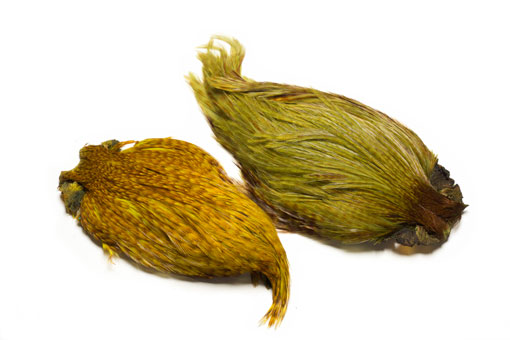Important to note these are dyed barred capes. When we dye feathers the dye acts like a filter, we see the original colour and markings through the dye colour. Pick the right natural material, dye it well, and humble, basic feathers and fur can become a whole lot more interesting. These capes are a fine example, and they do not cost a fortune.

One dyed olive, the other yellow/olive, the dye colours mix with gingery browns from the natural cape. The yellow/olive is super colour, I can see the dirty yellow on the unbarred parts of the feathers, over the barring on this cape it works very well indeed. A few turns of hackle and I have insect legs, a bunch of fibres and I have a wing. Same for the olive cape, more a light olive, again a few turns bring a hint of colour and subtle marking. (I prefer to use dyed hackles of this type with natural hackle, match the fibre length and add a turn or two of colour through a natural hackle.)
These are well dyed: lift the outer feathers and there are no undyed feathers. Indian capes typically have a little dried flesh and or fat on the inside of the skin, as do these. Not a problem if the cape is handled well, and these have been handled well. These came with the skin on paper towel to absorb any oils or fat – a thoughtful touch.
Excellent capes, skillfully dyed and presented. These capes are a little off the mainstream, handy but not a feather I need every day. At £7.50 per cape I can afford one, maybe two, for those times when I want a touch of colour.



